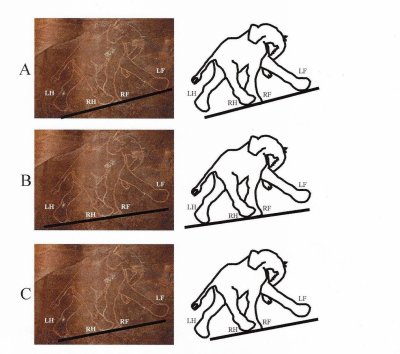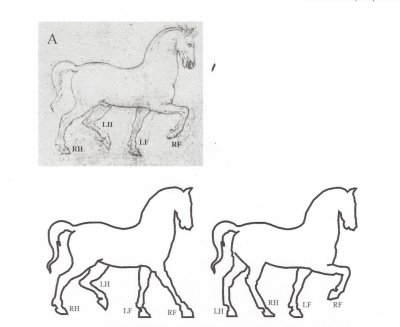The Fake Line
The Fake Line
Jean Luc Cornille

Just imagine how greater our relation with animals would be if we were allowed to watch them interacting instead of being imposed entertainments insulting our intelligence as well as the animal actors’ intelligence. In a circus, we are expected to applaud an elephant standing on a platform and lifting one leg. We know that to achieve this pathetic act, the elephant has been chained and beaten and even tortured as a baby. We are watching a stupid act that is prepared using dumb training techniques and we applaud because the entertainment industry has lowered our IQ.
Just imagine presenting a problem to two elephants and watch them teaming up their thoughts and actions to resolve the “question.” A group of scientists created a situation where only the combine action and thinking of two elephants working in partnership could resolve. They placed two cups of food on a table that is too far from the fence to be accessed just by the length of the trunk. They placed a rope around the table that is too short to be pulled by a single elephant. Instead, if the two elephants pull together on each end of the rope, they can slide the table close form the fence and eat the food.
Could the two elephants assess the situation and elaborate a partnership resolving the problem? Not only they did, but faster that a group of chimpanzees that was subjected to a comparable experiment years earlier. The protocol was different but the aim was creating a situation where two chimpanzees had to coordinate their actions. Impressed by the cleverness of the elephants, Joshua Plotnick and his team complicated a little the task of the elephants rendering one side of the rope inaccessible to the other elephants. They delayed the arrival of the second elephant up to 45 seconds and the other waited patiently having understood that there was no point on pulling on one side of the rope if the partner was not there pulling on the other side. It was twelve elephants involved in the experiment paired in six group of two. It became quickly obvious that elephants were capable to adapt to the style of their partner. When one pulled faster, the other resisted and so on. The experiment lasted three days and the percentage of success, the table pulled against the fence allowing access to the food, was very high.
Joshua M. Plotnik, Richard Lair, Wirot Suphachoksahakun, and Frans B.M. de Waal
Just imagine that this experiment would be the subject of a circus act. The loud music would shut off, allowing peoples’ brain to function again. The subject of the experiment would be clearly explained and kids and adult would learn about intelligence watching two gentle giants resolving cleverly and peacefully a problem. The brain of the kids would be impressed by the intelligence of the pachyderms and not for the pathetic circus acts that the industry of entertainment wanted them to admire. The brain of the students would measure the deepness of Tom Regan’s thought, “Because we have viewed other animals through the myopic lens of our self-importance, we have misperceived who and what they are. Because we have repeated our ignorance, one to the other, we have mistaken it for knowledge.” Adults’ brain would realize that much greater knowledge and respect can be achieve watching animal living their lives instead of pulling the trigger.
Interestingly, cavemen were better at depicting quadrupedal walking than modern artists.  Prior to the photographic series of Eadweard Muybridge, the marge of errors of quadruped walking illustration was 83.5%, which is higher that the range of error rate of 73.3%, that is the percentage of errors that anyone trying to illustrate quadrupedal locomotion base on the observations of a naked eye, is likely to commit. The numbers suggest that modern artists were more interested in dramatic painting than accuracy I locomotion. After Muybridge, the percentage of errors decreased to 57.9%, which is still higher than the upper paleolithic, Homo Sapiens, who are referred to as cavemen, in this study. Their range of error rate was very low, 46.2%. Cavemen lived in close contact with the animals that they hunted; their hunting techniques were close range and when situations evolved the wrong way, their capacity of anticipating the animal’s next move was a great art of their survival.
Prior to the photographic series of Eadweard Muybridge, the marge of errors of quadruped walking illustration was 83.5%, which is higher that the range of error rate of 73.3%, that is the percentage of errors that anyone trying to illustrate quadrupedal locomotion base on the observations of a naked eye, is likely to commit. The numbers suggest that modern artists were more interested in dramatic painting than accuracy I locomotion. After Muybridge, the percentage of errors decreased to 57.9%, which is still higher than the upper paleolithic, Homo Sapiens, who are referred to as cavemen, in this study. Their range of error rate was very low, 46.2%. Cavemen lived in close contact with the animals that they hunted; their hunting techniques were close range and when situations evolved the wrong way, their capacity of anticipating the animal’s next move was a great art of their survival.
Quite often, the position of the horse’s legs on cavalry statues are symbolic, for instance, an elevated right front knee, might indicates that the General riding the horse died in combat. Even Leonardo da Vinci who was very well known for his unusual ability to “see” wings movements during flight, did not depicted accurately the limbs movements of his walking horse.  Two corrections are possible; one is keeping the hind legs posture and adapt the front legs positons to the kinematics of the hind legs at this instant. The other correction could be keeping the forelegs as depicted by Leonardo and placing the hind legs as they would be at the sequence of the stride illustrated by the front legs.
Two corrections are possible; one is keeping the hind legs posture and adapt the front legs positons to the kinematics of the hind legs at this instant. The other correction could be keeping the forelegs as depicted by Leonardo and placing the hind legs as they would be at the sequence of the stride illustrated by the front legs.
If we look at the three options from a purely artistic perspective, Leornardo’s option is the flashiest one. Many artistes opted for these embellishments, as well as many riders and trainers. The elevation, amplitude, rhythm of the forelegs movements during piaff is the outcome of an elastic strain energy stored in the long tendons of the lower legs, the internal tendon of the biceps brachii, the muscles which act like tendons even in the absence of tendons, the aponeurosis of larger muscles such as the serratus ventralis thoracic. This subtle use of energy is influenced by the direction, intensity, duration and frequency of the forces coming from the hind legs. Forward shift of the weight over the forelegs is resisted by the decelerating activity of the supporting hind leg. The work is continued by the conversion through the back muscles of the thrust generated by the hind legs into upward forces. There are concepts such a transport of forces that use muscles and tendons. There are the constant inversions of the forces acting form the limb down to the ground and from the ground up to the limbs. We have talked about these transfer of forces in pervious articles. All this knowledge is not in the equitation of classical authors.
The most talented intuitively figured a part of this sophisticate network but they did not figure the whole picture. This is where science is now offering two decisive choices. One is embellishing poor riding and training techniques and this is what low trainers do stimulating the horse hind and front legs with a bamboo pole. They try to embellish poor gestures instead of providing to the equine athlete the athletic development and coordination allowing full expression of the horse’s talent. The other choice is flying above the “BS lines” and sublimate the horse’s talent with advanced knowledge of how their physique executes the moves.
Month ago, a friend of ours, who is a great artist looked above my shoulder a I was finishing an illustration for an article. She asked me, “Why do you add these BS lines? I told her, “I don’t feel I succeeded to fully express the role of the biceps brachii.” “So you add a few BS lines to cover up a bad draw. That’s not your standards. A lot of low artist do that, BS verses art and science. In your art, there is a living creature that will try to do what he is asked to do and he will suffer from these BS lines. “I redid the drawing and there was no need of fake lines. Jean Luc Cornille



 twitter
twitter facebook
facebook pinterest
pinterest linkedin
linkedin